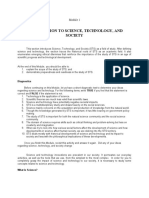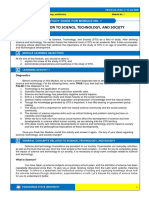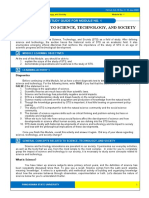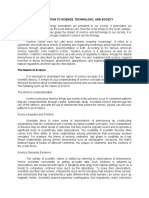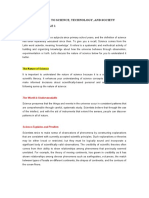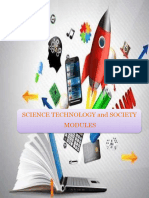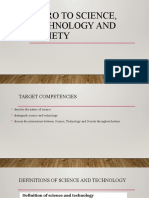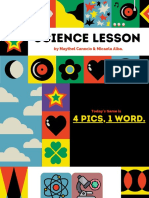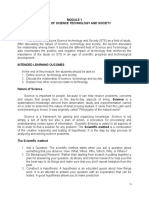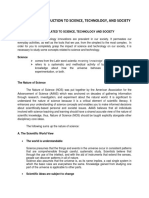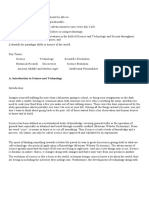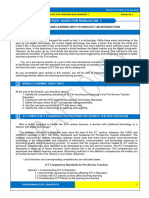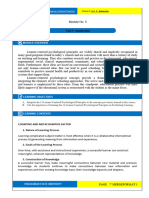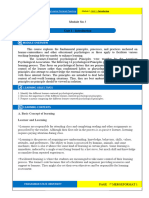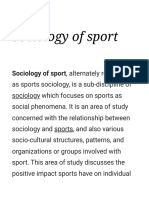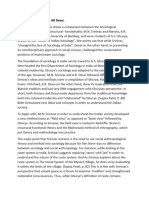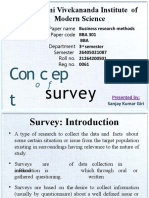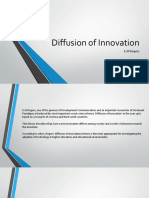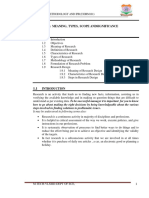FM-AA-CIA-15 Rev.
0 10-July-2020
STUDY GUIDE FOR MODULE NO. 1
INTRODUCTION TO SCIENCE, TECHNOLOGY, AND
SOCIETY
MODULE OVERVIEW
This section introduces Science, Technology, and Society (STS) as a field of study. After defining science
and technology, the section traces the historical roots of STS as an academic field. It also enumerates emerging
ethical dilemmas that reinforce the importance of the study of STS in an age of scientific progress and
technological development.
MODULE LEARNING OBJECTIVES
At the end of this Module, you should be able to:
1. explain the scope of the study of STS; and
2. demonstrate preparedness and readiness in the study of STS.
LEARNING ACTIVITY 1
Diagnostics
Before continuing on this Module, let us have a short diagnostic test to determine your ideas regarding
science and technology. For the following items, write TRUE if you feel that the statement is correct and FALSE if
the statement is not.
1. Technology is the application of science.
2. Scientific theories are much less valid than scientific laws.
3. Science and technology has potentially negative societal impacts.
4. STS is a multidisciplinary study and draws heavily on the social sciences.
5. Science mainly concerns on the acquisition and production of knowledge from the natural world.
6. Though the knowledge generated by STS is important, it has little bearing on government policy-making.
7. The study of STS is important for both the natural science community and the social science community.
8. The domain of science requires skills such as critical thinking and problem-solving but less on creativity
and imagination.
9. When we try to look into how various social factors affect the development of science and how
developments in science affect human society, we are delving into the STS territory.
10. STS deals mostly with historical developments of science and technology and its impact to society and
less with the philosophical implications of these developments.
Once you finish this Module, revisit this activity and answer it again. Did any of your ideas regarding
science, technology, and society change?
GENERAL CONCEPTS RELATED TO SCIENCE, TECHNOLOGY, AND SOCIETY
Science and technology innovations are prevalent in our society. It permeates our everyday activities, as
well as the tools that we use, from the most simple to the most complex. In order for you to completely grasp the
impact of science and technology to our society, it is necessary to study some concepts related to science and
technology.
What is Science?
You have taken up science subjects since primary school years, and the definition of science has been
repeatedly discussed since then. To give you a recall, Science comes from the Latin word scientia, meaning
‘knowledge’. It refers to a systematic and methodical activity of building and organizing knowledge about how the
universe behaves through observation, experimentation or both. Let’s discuss the nature of science below for you
to understand it better.
The Nature of Science
It is important to understand the nature of science because it is a critical component of scientific literacy. It
enhances your understanding of science concepts and enables you to make informed decisions about
scientifically-based personal and societal issues. The following sums up the nature of science:
The World is Understandable
PAGE \* MERGEFORMAT 1
� FM-AA-CIA-15 Rev. 0 10-July-2020
Science presumes that the things and events in the universe occur in consistent patterns that are
comprehensible through careful, systematic study. Scientists believe that through the use of the intellect, and with
the aid of instruments that extend the senses, people can discover patterns in all of nature.
Science Explains and Predicts
Scientists strive to make sense of observations of phenomena by constructing explanations that are
consistent with currently accepted scientific principles. Such explanations or theories may be either broad or
restricted, but they must be logically sound and incorporate a significant body of scientifically valid observations.
The credibility of scientific theories often comes from their ability to show relationships among phenomena that
previously seemed unrelated. For example, the theory of moving continents, has grown in credibility as it has
shown relationships among diverse phenomena such as earthquakes, volcanoes, the match between types of
fossils on different continents, the shapes of continents, and the contours of the ocean floors.
Science Demands Evidence
The validity of scientific claims is settled by referring to observations of phenomena. Hence, scientists
concentrate on getting accurate data. Such evidence is obtained by observations and measurements taken in
situations that range from natural settings (such as a forest) to completely contrived ones (such as the laboratory).
To make their observations, scientists use their own senses, instruments (such as microscopes) that enhance
those senses, and instruments that tap characteristics quite different from what humans can sense (such as
magnetic fields). Scientists observe passively (earthquakes, bird migrations), make collections (rocks, shells), and
actively probe the world (as by boring into the earth's crust or administering experimental medicines).
Scientific Ideas are Open to Change
Science is more of a process than a set body of knowledge. Scientists are always testing and revising
their ideas, and as new observations are made, existing ideas may be challenged. Ideas may be replaced with
new ideas that better fit the facts, but more often existing ideas are simply revised. For example, when scientists
discovered how genes control genetic traits, they didn't throw out Mendel's laws of inheritance. The new
discoveries helped to explain why Mendel's laws apply to certain traits but not others. They showed that Mendel's
laws are part of a bigger picture. Through many new discoveries over time, scientists gradually build an
increasingly accurate and detailed understanding of the natural world.
Science is a Complex Social Activity
Scientific work involves many individuals doing many different kinds of work and goes on to some degree
in all nations of the world. Men and women of all ethnic and national backgrounds participate in science and its
applications. These people --- scientists and engineers, mathematicians, physicians, technicians, computer
programmers, librarians, and others --- may focus on scientific knowledge either for its own sake or for a particular
practical purpose, and they may be concerned with data gathering, theory building, instrument building, or
communicating.
Science Cannot Provide Complete Answers to All Questions
There are many matters that cannot usefully be examined in a scientific way. There are, for instance,
beliefs that --- by their very nature --- cannot be proved or disproved (such as the existence of supernatural
powers and beings, or the true purposes of life). In other cases, a scientific approach that may be valid is likely to
be rejected as irrelevant by people who hold to certain beliefs (such as in miracles, fortune-telling, astrology, and
superstition). Nor do scientists have the means to settle issues concerning good and evil, although they can
sometimes contribute to the discussion of such issues by identifying the likely consequences of particular actions,
which may be helpful in weighing alternatives.
Extension Activity
You can watch this YouTube video from Bozeman Science to further understand the Nature of Science:
https://www.youtube.com/watch?v=TkvjDZseD4k&feature=emb_rel_pause
What is Technology?
Technology, the word often attached side by side with science comes from the Greek word techne,
meaning ‘art, skill or cunning of hand’. Technology involves the development and use of materials, tools, and
approaches for solving human problems and helping to fulfill human needs and desires. Many of the products of
technology help humans accomplish tasks that would otherwise be very difficult or impossible to carry out.
Although technology provides many benefits, it also produces associated costs and risks. Technology is also a
way of knowing, and is also a process of exploration and experimentation. Technology is both a form of
knowledge that uses concepts and skills from other disciplines and the application of this knowledge to meet an
identified need or to solve a specific problem using materials, energy, and tools.
PAGE \* MERGEFORMAT 1
� FM-AA-CIA-15 Rev. 0 10-July-2020
Relationship between Science, Technology, and Society
Science, technology and society are closely linked, especially through scientific inquiry, technological
problem solving, and communication. Science frequently utilizes and requires tools and processes developed by
technology, and conversely, technology often employs principles, laws, theories, and processes developed by
means of science. The society as we know it today has been affected in many ways by science and technology.
For example, society demands for an easy-access, extensive and frequent communication. This leads to
the research and development of an ever widening array of mobile phone capabilities. Access to these
capabilities, in turn, influenced the way humans live. As the society relies more and more on mobile phones,
additional features were continuously requested to improve like increasing speed of phone processors, the use of
touch-enabled screens, or the implementation of mobile internet access, and the cycle continues.
HISTORICAL ROOTS OF STS AS AN ACADEMIC FIELD
As problems in science and technology continue to rise and become more observable, the need to pay
attention to their interactions with various aspects of human life, e.g. social, political, and economic, becomes
ever more necessary. How the different aspects of society shape and influence the progression and further
development of science and technology is the area of concern of a relatively new academic discipline called
Science, Technology and Society.
Science, Technology, and Society (STS) is a relatively young field that combines previously independent
and older disciplines, such as the history of science, philosophy of science, and sociology of science. As an
academic field, STS, according to Harvard University’s Kennedy School (2018), traces its roots from the interwar
period and the start of the Cold War. It was during this period when historians and scientists found interest in the
interconnections of scientific knowledge, technological systems, and society. The rise of STS as an academic
field resulted from the recognition that many schools today do not really prepare students to respond critically,
reflectively, and proactively to the challenges posed by science and technology in the modern world.
THE IMPORTANCE OF THE STUDY OF STS
STS seeks to bridge the gap between two traditionally exclusive cultures --- humanities (interpretive) and
natural sciences (rational) --- so that humans will be able to better confront the moral, ethical, and existential
dilemmas brought by the continued developments in science and technology.
STS also calls for educating you (our students) so that you will be able to apply science and technology
(tools, knowledge, process and products) to solve problems in your environment. STS is an important academic
discipline to help you do science so as to be functional and not just graduates who are alien to your own society.
For example, graduates should be able to apply science and technology while at school, say to be productive, to
grow your own food, to carry-out diseases preventive measures and to become self-reliant or employed. STS
aims to help students to develop adaptability, equipped with not only academic skills but with a range of practical
skills which will make you a functional citizen.
ETHICAL DILEMMAS THAT REINFORCE THE IMPORTANCE OF THE STUDY OF STS
Human beings are by no means perfect – we struggle with ethical dilemmas on a daily basis and fail in
doing what we think or believe to be the right thing more often than we would like to admit. Unfortunately, these
failings are also articulated in our technology.
To warn us of these failings, the John J. Reilly Center for Science, Technology, and Values at the University
of Notre Dame compiles an annual list of what it determines to be that year’s top 10 ethical dilemmas in science
and technology. The list points to the challenges, questions, and issues that need to be addressed and resolved
when science, and technology and humanity intertwine.
The top 10 ethical dilemmas of science and technology as identified by the John J. Reilly Center for
Science, Technology, and Values at the University of Notre Dame for 2020 can be viewed at this link:
www.laboratoryequipment.com/558920-Top-10-Ethical-Dilemmas-in-Science-for-2020/. You may also
view the dilemmas from previous years as listed by the said organization.
Even if several items in the list may sound unfamiliar to you, it can be a useful springboard in the study of science
and technology.
LEARNING ACTIVITY 2
PAGE \* MERGEFORMAT 1
� FM-AA-CIA-15 Rev. 0 10-July-2020
Metacognitive reading report
1. Refer to the work of Lewis Wolpert entitled The Medawar Lecture 1998 Is Science Dangerous? through
the link https://www.ncbi.nlm.nih.gov/pmc/articles/PMC1569503/. Read the article and answer the
following questions:
a. What were Wolpert's major points and support to his claims?
b. Does he believe that science and technology is dangerous?
c. What were his ideas regarding eugenics, cloning, and stem cells? Do you agree or disagree on his
points regarding these issues? Why or why not?
d. What role does the public play in the purported dangers (or lack thereof) of science and technology?
e. What role does politics play in the purported dangers (or lack thereof) of science and technology?
f. What three concepts from the article will you never forget?
g. What three realizations did you have after reading the article? State your answer in the following
manner: Before reading the article I thought… However after reading, I can now say that I learned…
h. What three things are still unclear to you after reading the article?
Poster-making
2. On an A4 size coupon bond, create a poster or collage that reflects your view of science and technology.
It should clearly show whether you view science and technology as good, bad, both good and bad or
neither. Be creative. You can use different art materials to make it visually appealing and impactful. On
another piece of paper, briefly explain your work using 5-10 sentences. Your work will be scored using
the following criteria:
4 3 2 1
Creativity and Work is inventive Work shows a high Work shows some Work is not
Originality and shows a high degree of degree of original.
degree of imagination and inventiveness and
imagination and resourcefulness. resourcefulness.
resourcefulness.
Visual appeal The poster is The poster is The poster is The poster is
exceptionally attractive in terms tolerably attractive messy and poorly
attractive in terms of layout, design, in terms of layout, designed and
of layout, design, and neatness. design, and layed out
and neatness. neatness.
Clarity of The message of The message of The message of The message of
message the poster is the poster is clear the poster is the poster is
exceptionally clear and impactful. comprehensible incomprehensible.
and impactful. but may lack
impact.
Explanation The explanation The explanation The explanation The explanation
was complete, was complete and was complete, but was incomplete,
concise, and clear. clear. may be long- long-winded, and
winded or unclear. unclear.
Timeliness Completed work Completed work Completed work Completed work
was passed earlier was passed on the was passed the was passed more
than the deadline deadline given. day after the than a day after the
given. deadline given. deadline given.
SUMMARY
The following learning points summarize what you have learned in this section:
Science is a systematic and methodical activity of building and organizing knowledge about how the
universe behaves through observation, experimentation or both.
Scientists assume that nature can be understood through systematic study, scientific ideas are open to
revision, sound scientific ideas withstand the test of time, and science cannot provide answers to all
questions.
Technology involves the development and use of materials, tools, and approaches for solving human
problems and helping to fulfill human needs and desires.
STS as an academic discipline is primarily concerned with how the different aspects of society shape and
influence the progression and further development of science and technology.
STS seeks to bridge the gap between humanities and natural sciences.
PAGE \* MERGEFORMAT 1
